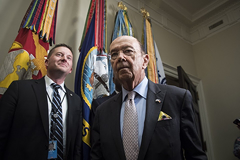Trump’s team is ready for a trade war over steel
14/07/2017 12:00

The Trump administration expects other countries to retaliate against its planned restrictions on steel imports, but Commerce Secretary Wilbur Ross told lawmakers the move could be a necessary step to draw countries like China into new negotiations.
At the closed-door briefing on Thursday afternoon, several lawmakers, led at times by Sen. Rob Portman (R-Ohio), told Ross that China — and potentially other countries — could place their own restrictions against U.S. goods if the Trump administration decided to impose tariffs or quotas against steel imports, people who attended the briefing said.
But Ross responded that he was hopeful any action by the White House would prompt other countries to enter into new negotiations with the United States, saying that past efforts to press China to change its behavior have failed and that more extreme steps were necessary.
Trump said earlier this week he was considering imposing tariffs or quotas to help revive the U.S. steel industry. His advisers say that China's subsidies for its domestic steel industry have put U.S. workers at a disadvantage.The Trump administration launched two separate investigations in April into whether imports of steel and aluminum compromise U.S. national security. Trump's choice about what sort of protection to impose could be one of the most consequential economic decisions of his administration, as he has the ability to act unilaterally and does not need Congress's approval.
[Trump promises to crack down on foreign steel, but delays continue]
Trump is expected to make his decision based on recommendations from Ross, but the process has bogged down amid infighting within the White House on how to proceed.
At the meeting, which lasted more than an hour, Ross cited the example of the Reagan administration, which convinced Japan and other countries to take the initiative in reducing their exports after U.S. negotiators threatened to close them off from the American market.
In 1981, the Reagan administration convinced Japan to reduce the number of cars it was exporting to the United States in a bid to boost the U.S. auto sector. In 1984, the administration used the tactic again with the steel industry, as it told dozens of countries to either limit their steel shipments to the United States or lose access to the American market.
The Commerce Department declined to comment.
Ross said Thursday that he hoped to submit options for action to the president in the next week or so, but he did not clarify what those options would be, according to people who attended the meeting.
Ross had originally said that the report would be submitted by the end of June, but administration officials and industry leaders say it appears to have been delayed due to conflict within the White House about whether the United States should risk the international blowback that the measure could bring.
According to people who attended the Thursday briefing, Ross described the problem plaguing the global steel market as one of excess Chinese capacity, and presented poster boards showing how China’s steel production has skyrocketed in past decades and flooded the global market.
The first chart Ross presented depicted the issue of global steel overcapacity, comparing the output of steel mills in the United States, China and the rest of the world to illustrate how much China's steel production outpaces the United States, said a person with details of the meeting.
A second poster featured a bar graph showing how China's steel production has continued to rise in recent years, highlighted with notes about China's commitments to rein in their excess steel — an illustration of how China has ignored their own promises to restrain capacity. The third poster compared U.S. production of aluminum with production of the metal in China and the rest of the world, the person said.
China produces about half of the world’s steel capacity. It has many more steel mills sitting idle than the United States has in total.
In 2016, China ranked just 11th on the list of steel suppliers to the United States, according to data from the Commerce Department, behind closer U.S. allies like Canada, South Korea, Japan and Germany. But the U.S. steel industry argues that the massive amount of steel that China produces pushes down the global price of the metal anyway, forcing American producers to lower their prices to compete.
The current trade restrictions that the U.S. has on Chinese steel are not effective at addressing the overcapacity problem, Ross told lawmakers and congressional aides at the meeting, because Chinese steel is funneled through other countries and then later into the United States.
Ross named Vietnam, South Korea, Russia and Ukraine as the most problematic conduits for Chinese steel, according to a Senate aide who attended the meeting. Ross acknowledged that Canada is a large source of both imports and exports for the U.S. steel industry, and noted that it had not added much steel production capacity recently, the aide said.
Ross said he understood that some exclusions to any restrictions would be necessary, but that the administration did not want to create too many loopholes in its plan, another person in the meeting said.
Many of the lawmakers in attendance expressed concern about the potential for retaliation from trading partners to cut off markets for goods made in their states. Sen. Pat Roberts (R-Kan) in particular described farming groups fearing that steel restrictions could trigger a retaliatory blowback that would hurt U.S. agricultural exports.
Ross acknowledged the risk of retaliation from other countries but said that legal challenges could take several years to foment at the World Trade Organization.
He also acknowledged the risk of prices rising for downstream industries that use steel to make their products, like automakers. But he said that if prices went up on autos, he didn’t expect them to rise by a meaningful amount, the Senate aide said.
At the closed-door briefing on Thursday afternoon, several lawmakers, led at times by Sen. Rob Portman (R-Ohio), told Ross that China — and potentially other countries — could place their own restrictions against U.S. goods if the Trump administration decided to impose tariffs or quotas against steel imports, people who attended the briefing said.
But Ross responded that he was hopeful any action by the White House would prompt other countries to enter into new negotiations with the United States, saying that past efforts to press China to change its behavior have failed and that more extreme steps were necessary.
Trump said earlier this week he was considering imposing tariffs or quotas to help revive the U.S. steel industry. His advisers say that China's subsidies for its domestic steel industry have put U.S. workers at a disadvantage.The Trump administration launched two separate investigations in April into whether imports of steel and aluminum compromise U.S. national security. Trump's choice about what sort of protection to impose could be one of the most consequential economic decisions of his administration, as he has the ability to act unilaterally and does not need Congress's approval.
[Trump promises to crack down on foreign steel, but delays continue]
Trump is expected to make his decision based on recommendations from Ross, but the process has bogged down amid infighting within the White House on how to proceed.
At the meeting, which lasted more than an hour, Ross cited the example of the Reagan administration, which convinced Japan and other countries to take the initiative in reducing their exports after U.S. negotiators threatened to close them off from the American market.
In 1981, the Reagan administration convinced Japan to reduce the number of cars it was exporting to the United States in a bid to boost the U.S. auto sector. In 1984, the administration used the tactic again with the steel industry, as it told dozens of countries to either limit their steel shipments to the United States or lose access to the American market.
The Commerce Department declined to comment.
Ross said Thursday that he hoped to submit options for action to the president in the next week or so, but he did not clarify what those options would be, according to people who attended the meeting.
Ross had originally said that the report would be submitted by the end of June, but administration officials and industry leaders say it appears to have been delayed due to conflict within the White House about whether the United States should risk the international blowback that the measure could bring.
According to people who attended the Thursday briefing, Ross described the problem plaguing the global steel market as one of excess Chinese capacity, and presented poster boards showing how China’s steel production has skyrocketed in past decades and flooded the global market.
The first chart Ross presented depicted the issue of global steel overcapacity, comparing the output of steel mills in the United States, China and the rest of the world to illustrate how much China's steel production outpaces the United States, said a person with details of the meeting.
A second poster featured a bar graph showing how China's steel production has continued to rise in recent years, highlighted with notes about China's commitments to rein in their excess steel — an illustration of how China has ignored their own promises to restrain capacity. The third poster compared U.S. production of aluminum with production of the metal in China and the rest of the world, the person said.
China produces about half of the world’s steel capacity. It has many more steel mills sitting idle than the United States has in total.
In 2016, China ranked just 11th on the list of steel suppliers to the United States, according to data from the Commerce Department, behind closer U.S. allies like Canada, South Korea, Japan and Germany. But the U.S. steel industry argues that the massive amount of steel that China produces pushes down the global price of the metal anyway, forcing American producers to lower their prices to compete.
The current trade restrictions that the U.S. has on Chinese steel are not effective at addressing the overcapacity problem, Ross told lawmakers and congressional aides at the meeting, because Chinese steel is funneled through other countries and then later into the United States.
Ross named Vietnam, South Korea, Russia and Ukraine as the most problematic conduits for Chinese steel, according to a Senate aide who attended the meeting. Ross acknowledged that Canada is a large source of both imports and exports for the U.S. steel industry, and noted that it had not added much steel production capacity recently, the aide said.
Ross said he understood that some exclusions to any restrictions would be necessary, but that the administration did not want to create too many loopholes in its plan, another person in the meeting said.
Many of the lawmakers in attendance expressed concern about the potential for retaliation from trading partners to cut off markets for goods made in their states. Sen. Pat Roberts (R-Kan) in particular described farming groups fearing that steel restrictions could trigger a retaliatory blowback that would hurt U.S. agricultural exports.
Ross acknowledged the risk of retaliation from other countries but said that legal challenges could take several years to foment at the World Trade Organization.
He also acknowledged the risk of prices rising for downstream industries that use steel to make their products, like automakers. But he said that if prices went up on autos, he didn’t expect them to rise by a meaningful amount, the Senate aide said.
Source: The Washington Post
Các tin khác
- Exports face challenges despite enjoying robust growth (26/04/2024)
- Vietnam ranks fifth among aquatic product suppliers for Singapore (26/04/2024)
- Some firms likely to close due to higher anti-dumping tariff on plywood products in S Korea (26/04/2024)
- Foreign businesses increasingly seek export sources in Vietnam (26/04/2024)
- Japan's investigation into China's graphite electrodes to 'affect regional cooperation' (26/04/2024)
 Home
Home
 About Us
About Us




















